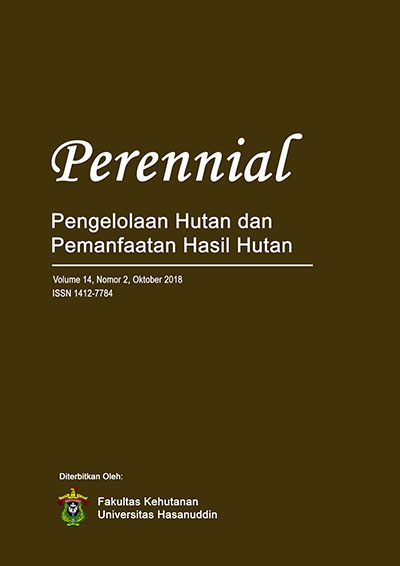Produksi Umpan Rayap dari Limbah Bahan Organik dan Efektivitasnya dalam Pengendalian Serangan Coptotermes sp.
DOI:
https://doi.org/10.24259/perennial.v14i2.5665Abstract
Damages of building construction due to termite attacks have caused high economic losses and therefore, efforts are continuously developed to overcome the serious problem. Baiting system is one way to control termite attacks as it consists of acceptable termite food sources, combined with a slow-acting substance lethal to termites. This study was conducted to produce termite bait materials from organic waste mixtures and evaluate its effectiveness against termite attacks in the field. The termite baits were produced by mixing paper, cardboard, and degraded pine wood, combined with leaves of Melaleuca leucadendron Linn assumed to be toxic to termites. Tapioca starch was used as glue and added to the organic materials mixture before pressed at room temperature with the target density of 1.0 g/cm3. The produced baits were placed in the field with signs of heavy attacks of termites, Coptotermes sp., and observed every three days for the termite elimination. Results showed that the bait formulation enables to significantly eliminate the termite attacks with high attractant properties. However, its effectiveness was still lower than the commercial bait due to its high capacity of water absorption, indicating the importance of further research on its mixture and glue formulation.References
Djunaedy, A. (2007). Efektivitas teknik aplikasi agens hayati Heterorhabditis, (all strain) isolat lokal Madura terhadap pengendalian rayap tanah Macrotermes sp. di lapang. Skripsi Jurusan Budidaya Pertanian Fakultas Pertanian Trunojoyo, Madura. (Tidak Dipublikasikan).
Erli, Wardenaar, E., & Muflihati. (2015). Uji aktivitas minyak atsiri daun salam (Syzigium polyanthum Walp) terhadap rayap tanah (Coptotermes curvignathus Holmgr). Jurnal Hutan Lestari, 3 (2).
French, J.R.J. (1996). Subterranean termite, Reticulitermes spp (Isoptera: Rhinotermitidae), colony response to baiting with hexaflumuron using prototype commercial termite baiting system. Journal of Entomological Science, 31, 143-151.
Grace, J.K., & Su, N.Y. (2001). Evidence supporting the use of termite baiting system for long-term structural protection (Isopteran). Sociobiology, 37 (2), 301-310.
Indrayani, Y., Muin, M. ., & Yoshimura, T. (2016). Crude extracts of two different leaf plant species and their responses against subterranean termite Coptotermes formosanus. Nusantara Bioscience, 8 (2), 226-231.
Kardinan, A. (2007). Tanaman pengusir dan pembasmi nyamuk vol. III. Jakarta: Agro Media Pustaka.
Mahathir, M. (2014). Efektifitas umpan rayap berbahan aktif hexaflumuron 0,5% dengan medium serbuk gergaji kayu pinus (Pinus Merkusii Jungh et de Vries). Skripsi pada Institut Pertanian Bogor (Tidak Dipublikasikan).
Muin, M., Arif, A., Nuraeni, S., & Zohra, W.O.F. (2014). Formulasi umpan dari campuran kayu terdegradasi dan kertas limbah untuk pengendalian rayap. Jurnal Ilmu Teknologi Kayu Tropis, 13 (1), 61-69.
Nandika, D., Rismayadi, Y., & Diba, F. (2003). Rayap: biologi dan pengendaliannya. Surakarta: Muhammadiyah University Press.
Lesmana, S. (2015, 10 Mei). Kerugian akibat serangan rayap capai Rp. 18,68 triliun. Diakses pada 29 November 2017 dari http://www.sainsindonesia.co.id/index.php/en/kabar-terkini/ 1528-kerugian-akibat-serangan-rayap-capai-rp-1868-triliun.
Noviansari, R., Sudarmin, & Siadi, K.. (2013). Transformasi Metil Eugenol Menjadi 3-(3,4 Dimetoksi Fenil)-1-Propanol Dan Uji Aktivitasnya Sebagai Antibakteri. Jurnal Jurusan Kimia FMIPA, 2 (2), 114-118.
Padlinurjaji, I. (1995). Keterawetan kayu Pinus merkusii Jungh et de Vr. Dengan wolmanit CB dan bafilit CFK secara perendaman dan kemungkinan penerapannya. Disertasi pada Institut Pertanian Bogor.
Robertson, & Su, N.Y. (1995). Discovery of an affective slow-acting insect growth regulator for controlling subterranean termites. Journal Down To Earth, 50 (1), 1-7.
Scheffrahn, R H., & Su, N.Y. (1991). Laboratory evaluation of two slow acting toxicants against formosan and eastern subterranean termites (Isoptera: Rhinotermitidae). Journal of Economic Entomology, 84, 170–175.
Simbolon, R.I., Indrayani, Y., & Husni, H. (2015). Efektifitas Bioatraktan Dari Lima Jenis Tanaman Terhadap Rayap Tanah (Coptotermes sp). Jurnal Hutan Lestari, 4 (1), 40-46.
Sornnuwat, Y., Vongkalung, C., & Takematsu, Y. (2004). A systematic key to termites of Thailand. Kasetsart Journal, 38, 349-368.
Sucipto. (2009). Optimasi penggunaan NaOH dan tapioka pada produksi kertas seni dari pelepah pisang. Jurnal Teknologi Pertanian, 10 (1), 46-53.
Tambunan, B., & Nandika, D. (1989). Deteriorasi kayu oleh faktor biologis. Bogor: Pusat Antar Universitas Bioteknologi, Institut Pertanian Bogor.


